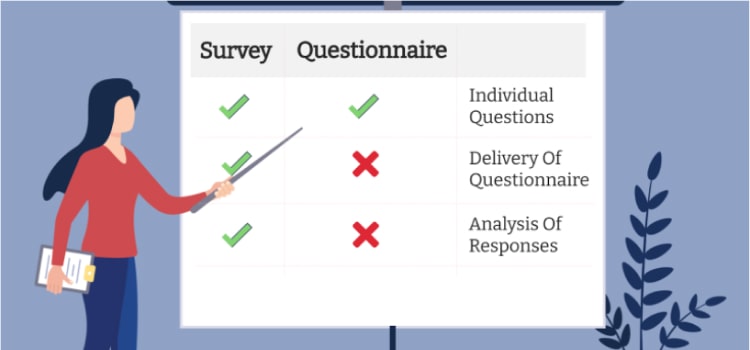Imagine you want to collect data for your business. Before you rush to get that data, consider a survey vs. questionnaire. Both are very similar, and some people use the terms interchangeably. However, there are differences between the two. Those differences can affect how and when you use each type of document or form.
Keep reading to learn more.
A classic showdown: Survey vs. Questionnaire
When learning about the difference between surveys and questions, it helps to understand the basics. That way, you'll be able to decide when to use the different types of surveys or questionnaires when you want to collect answers from people. Standalone questionnaires and entire surveys both include a series of questions, but they serve different purposes. Consider what each of these things is and how they compare to each other.
What is a survey?
A survey is something that people and companies use to conduct research. You can also use different types of surveys, such as customer satisfaction surveys or demographic surveys.

Image source: MarketSplash
Regardless of the content, online surveys are becoming a popular collection method for data. You can write a list of survey questions and send the survey to people. A well-known example of a survey would be the US Census, which tracks where people live every 10 years. Many businesses will also send out survey questions to customers. That way, they can learn about the customer's experience to make the business better.
What is a questionnaire?
It can be hard to tell the differences between a survey and a questionnaire. They both feature a list of questions, so it's easy to mistake them. One of the most significant differences between surveys vs. questionnaires is how the collectors use the responses.
A questionnaire on its own may help someone collect emails for an email list. Another option is to require a questionnaire to give a customer a free meal. You may create an online questionnaire as part of an overall survey. Surveys collect more data and analyze it, while a questionnaire contains the questions only.

Image source: flair.hr
When to use a survey vs. a questionnaire
Even if you know how surveys and questionnaires differ, you may need to decide when to use each. Both can be useful for gathering information. However, you may need to use a survey when collecting data. Either way, consider when you'd use a survey or questionnaire as well as the pros and cons of each.
When to use a survey
You should use a survey when you're looking for customer feedback from your target audience or when you’re trying to research and understand your users. The survey responses will help you make informed decisions for your business. As you receive answers, track the response rate as well to determine if you're asking the right type of questions.
Surveys can help you gain actionable insights from your target market or potential leads. Then, you can learn about their purchase decisions. Purchase data can help when you're doing a market research project or another type of survey to gain feedback from respondents.
Disadvantages of surveys include the fact that they take more work. Not only do you have to choose the right questions and distribution method, but you have to analyze the results.
When to use a questionnaire
If you want to reach a larger audience, you may want to distribute a questionnaire. While you won't be tracking data from it, you can gain good insightful feedback. Questionnaires are great for collecting basic information from your customers.
That can help you decide how to price a product or service, for example. But the question type you use may be a bit different from that of a survey. You'll want to ask questions that are a bit more qualitative since data isn't a huge part of a questionnaire. The results can still give you actionable feedback to improve your business. However, a questionnaire is great to use when you first start a business. You can always adapt it into a more formal survey later.

Image source: Marketsplash
How to make an effective questionnaire
When writing a questionnaire, you have a lot to consider. While a questionnaire isn't as complex as a survey, you want to make it effective for your target audience. That way, you'll be able to get more responses from the right people. Here are some steps to follow when you make your next questionnaire.
Consider the goal
First, you should determine the goal of your questionnaire. Maybe you want to conduct simple market research to see if a product or service idea is viable. Or perhaps you want to collect email addresses and include a questionnaire as part of the signup process.
No matter what, your goal can help guide you as you select which questions to ask. You might choose to ask demographic questions to learn about your email subscribers. Or perhaps you include a multiple-choice question to get more responses.
You can also consider if this questionnaire will be part of a larger survey.
Then, you'll know to ask questions that lead to answers that will be easy to analyze. Even if you don't need to analyze the data, having a goal can help decrease dropout rates. You'll be able to direct the questionnaire in a way that makes sense. When the questionnaire is less confusing, it will be easier for people to complete.
Think about the format
You should also think about the format, especially when it comes to questionnaire design. Think about if you'll have people fill out the questionnaire on paper. If so, you'll want to consider how many pages the document is.
Digital questionnaires can be useful as well - especially if you are working on becoming a paperless office. However, you need to consider if respondents will use a mobile device or a desktop for answering the questions. More than half of Americans use a phone or tablet to browse the web.
If you want to get more people to complete the questions, you need to make it work on mobile. That way, people won't drop out because they can't see the entire list of questions. They also won't have to wait longer than necessary for questions to load.
Keep it short
You also need to think about the length of your survey. Many people don't have a long attention span, so they may leave the questionnaire if they get bored. Unfortunately, there's no set number of questions that you should ask. But you should keep it relatively short. As you list out the questions, think about how long it might take you to answer them. You can also go over the questions to see if any are unnecessary.
Consider asking a friend or colleague to review your questionnaire. They can tell you if the questions are short enough or if you have too many questions. A friend may also be able to recommend questions to remove to help more people fill everything out.
Use the right number of questions
As mentioned, the perfect number of questionnaire questions doesn't exist. If you have questions that you want people to spend a lot of time on, you may want to stick to two or three questions total.
However, if your questionnaire has a closed-ended question, that won't usually take much time. You can get away with adding more questions to the form. The quicker people answer questions, the sooner they'll get through them all. So if you don't mind quick responses, consider adding a few more questions. On the other hand, if you want more details, stick to fewer questions. Then, you can get more people to respond in full.
As you release various questionnaires, you should track the response rate at least. Even if you don't analyze the answers, the response rate can tell you if the questionnaire is too long. Then, you'll know you need to cut some questions to get more answers.
Make it easy
Regardless of the number of questions, make them as easy to answer as possible. Avoid using big words that most people won't understand. Use active language so that people can put themselves in the position of the question.
You should also avoid writing biased questions. That may help people answer the form, but you could inadvertently guide them in the wrong direction.
Even if you don't mean for that to happen, it can, and there are better ways to make questions easy. An example of a poor question might be, "The warm weather has been great. Are you looking forward to summer?" Meanwhile, a better question might be something like, "How do you feel about summer?"
Avoid black and white answers
When it comes to asking questions, avoid using black and white answers. You can use multiple-choice questions, but try not to make the answers true/false or agree/disagree. Instead, make the answers a sliding scale. You can do this with the numbers 0 to 10, and ask how much people agree with a statement on that scale. Another option is to give options like "not at all agree" or "slightly agree" to offer more options.
This will help you collect a larger variety of answers, so you can tell how much people agree with something. Offering a sliding scale is especially important if you don't include text boxes where people can further explain their answers.

How to make an amazing survey
If you want to make a survey, you can use a lot of the same steps as with a questionnaire. But it helps to consider some other steps specifically for larger surveys. That way, you'll be able to include the best questions. You can also make it easier for you and your team to review the answers. Here are some steps to consider when you want to make your next survey.
Start with the purpose
First, you need to determine the purpose of the survey. This is similar to the goal of a questionnaire, but consider how you plan to use the results.
If you want to improve customer service, then send out surveys after people make purchases.
Knowing the purpose can help you with everything from selecting the questions to determining how to track the data. You may also be able to decide which survey or form creation tools you should use. And of course, the purpose may help you with the survey design. Some popular survey goals include market research, solving a problem, and understanding someone's experience. The purpose or goal can help you create the most effective survey for right now, and you can always change it later.
Identify key data points
As you settle on a goal or purpose of the survey, you should figure out your key performance indicators (KPIs). In the case of a market research survey, you may track things like level of interest and willingness to pay a certain amount.
Regardless of the type of the survey, you may want to track the number of survey respondents. If you also track how many people receive the survey, you can track the response rate. All of this data can help you make better decisions. Knowing the data you want to track can also help you write the questions. Then, you won't have to worry about a random answer negatively affecting your results. You'll know that all of your questions and answers will relate in some way.
Make the survey short
As with a questionnaire, try not to make a survey too long. Shorter surveys will be easier for survey participants to fill out. They'll also have more time to spend on each question without extending the overall time.
If you add too many questions, you can also make it harder to analyze the data.
You may have more points to track, and it can get confusing. So stick to the main purpose to make answering and analyzing easier for everyone. You can always set up another survey to track something else. The data will be separate, so you don't have to worry about extra questions interfering with the main goal. It may take time to run another survey, but you'll thank yourself later.
Be direct
When wording your questions, avoid using complicated language. The more direct you can be, the easier it will be for participants to understand. They won't have to ask for clarification when filling out a survey in person.
For online surveys, people won't have to feel like they can't finish them because they don't understand what a question is asking. If you aren't sure if you have a clear or vague question, ask someone for feedback. Ideally, you'd ask someone in the target audience of the survey.
However, a colleague may also be able to tell you if a question is too hard to read or answer. Direct questions also tend to be shorter, so respondents can spend less time reading and more time answering. So consider how long your questions are as well. You may need to give some background information, but don't include more than necessary. Not only will this help readers, but you may get fewer ambiguous answers.
Ask one question at a time
While you may want to create a short survey, you don't want to double up on questions. For example, maybe you want to know which employee helped a customer and how that employee did. Instead of asking those things together, give each its own question. So the first question might be, "who helped you today?" The next question can then be a sliding scale that states, "from 0 to 10, how helpful was the employee?"
Consider if a question asks more than one thing.
Covering multiple things may be okay for one or two open-ended questions. But if all of your questions have multiple parts, it can be confusing for respondents to answer and hard for you to analyze. If you find you have too many questions when you separate parts, you have options. You can decide to keep it that way and have a longer survey. Alternatively, you might cut questions that you don't absolutely need to ask.
Use neutral language
Another thing to consider when writing questions is to keep the language neutral. Like with questionnaires, surveys with biased questions can lead to problems. You may get people to answer in a way that they wouldn't otherwise. Try not to lead people towards a more positive answer, even if it's the answer you want to hear. When you collect those types of responses, you may think something is better than it is.
That can make it hard to actually improve your business.
You should also avoid writing multiple choice answers with a bias. Instead of using terms like "the best" or "the worst" for answers, use terms like excellent, good, fair, or poor. You can also include answers like "not applicable" so that people don't have to answer good or bad if they can't go either way.
Use a survey tool
If you plan on making a digital survey then there is no reason for you to struggle even if you have little to no coding skills. There are plenty of online survey maker tools available to help you out. Airtable comes with forms and serves as an example of such a tool that has form building capabilities, but there are also plenty of other options out there that may be better suited to your needs.
Survey vs. Questionnaire: In Review
When deciding between a survey vs. questionnaire, you have a lot to consider. You need to consider the purpose and how you want to use the answers. Be sure to use Google to search for situations similar to use. Then, you can figure out for sure if a survey or questionnaire is the right option.
forms.app, your free form builder
- Unlimited views
- Unlimited questions
- Unlimited notifications




